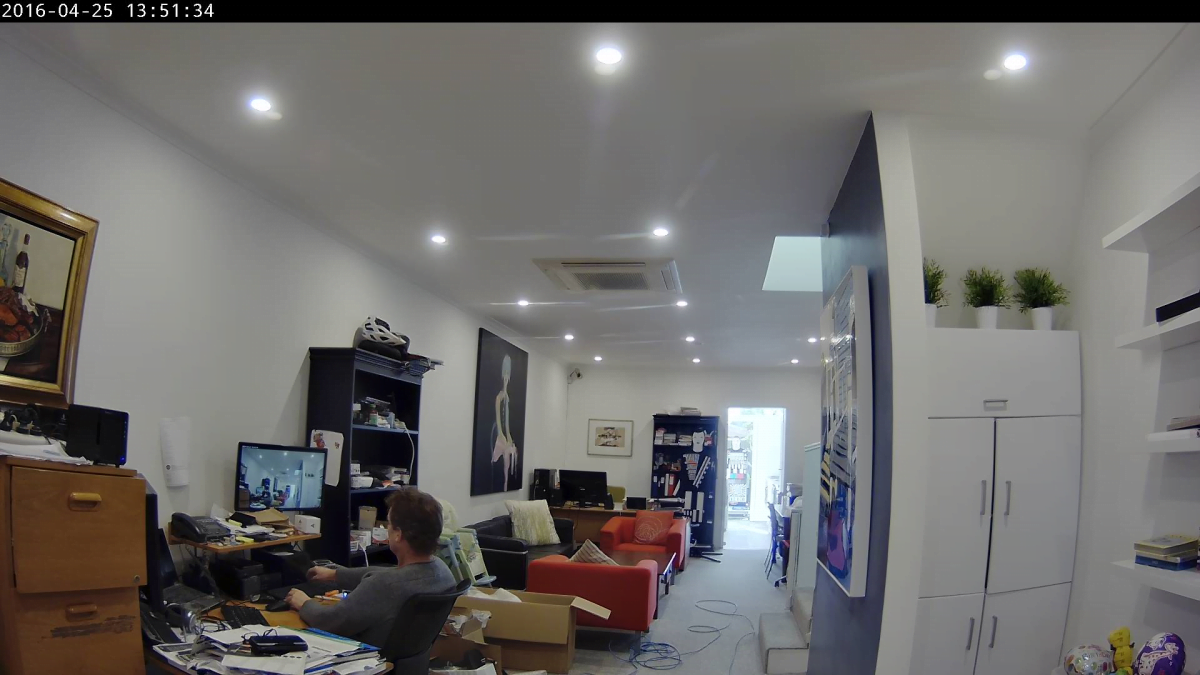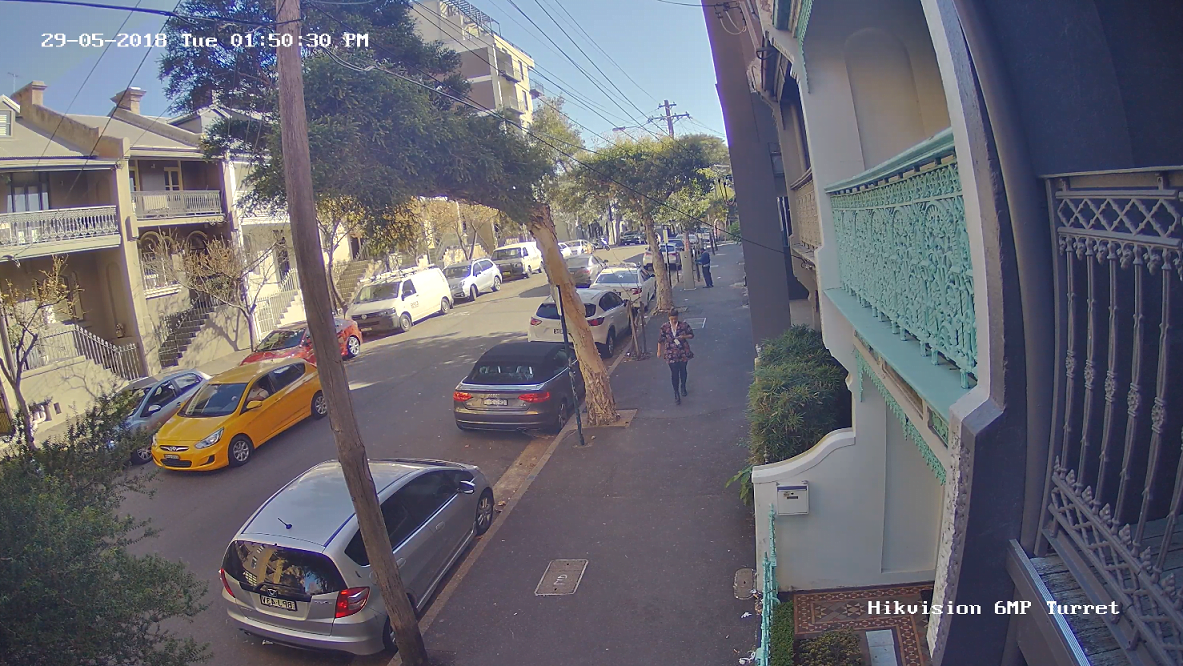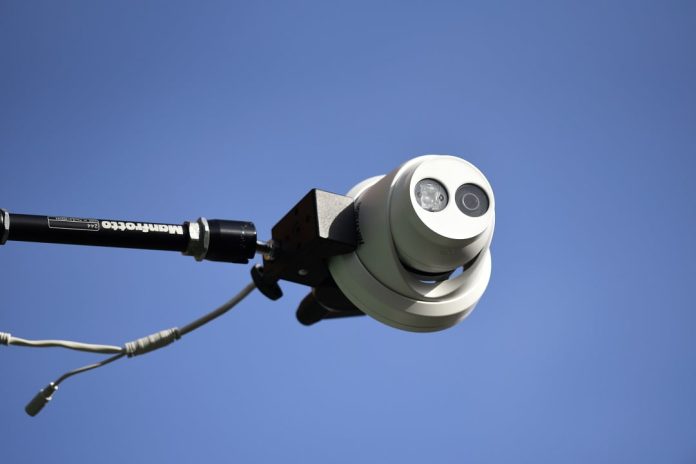HIKVISION’s DS-2CD2355FWD-I is a compact, affordable, 6MP fixed lens day/night turret camera with 30 metres of integrated IR and a robust IP67-rated housing making the unit more than capable of handling external applications where vandalism is less of a concern.
WE’VE tested an earlier version of Hikvision’s 1080p turret camera and found that within the limitations of the form factor, performance was better than expected, so I was mighty keen to get a sense of just how good this updated and recently unlocked 6MP Oceania-only version has become – as well as how effective the high-resolution sensor is as light levels fall.
Specifications are more comprehensive than you’d expect. The 6MP (3032 x 2008-pixel) ½.9-inch progressive scan CMOS sensor gives 20ips colour performance down to 0.01 lux at F1.2 with the support of auto gain and gives monochrome performance in 0 lux with the integrated IR activated. Bear in mind that this 6MP unit is Oceania only – the rest of the world gets the 5MP version, though all other specs remain the same.
The gimbal gives 0-365 degrees of pan and 0-75 degrees of tilt and shutter speed ranges from 1/3 of a second to 1/100,000th of a second. While this Hik turret comes with a fixed lens, you can choose your focal length – there’s 2.8mm (97-degree angle of view), 4 mm, (78-degree angle of view), 6mm giving a 60-degree angle of view), 8mm, giving a 39.5-degree angle of view and 12 mm, giving a 19-degree angle of view. My preference for the street scenes around the office would be 6mm but for most applications, 4mm or the 2.8mm that I’m testing would be ideal.
Wide dynamic range is 120dB and there’s backlight compensation and 3D digital noise reduction, triple streams as well as a bunch of compression options, including H.265+, H.265, H.264+, H.264 and MJPEG. The camera delivers 20ips at 5MP resolution in the main stream – the sub and third streams offer 30ips at up to full HD resolution. Image settings include rotate mode, saturation, brightness, contrast, sharpness adjustable by client software or web browser and region of interest.

Nice bokeh from the Nikon 300mm AFS inside 2 metres…
The camera also features comprehensive IVA, including behaviour analysis such as line crossing detection, intrusion detection, unattended baggage detection, object removal detection – there’s also exception detection, including scene change and the appearance of a human face in the scene. These IVA events can be used to send alerts or activate recording.
Protocols supported include TCP/IP, UDP, ICMP, HTTP, HTTPS, FTP, DHCP, DNS, DDNS, RTP, RTSP, RTCP, PPPoE, NTP, UPnP, SMTP, SNMP, IGMP, 802.1X, QoS, IPv6; there’s 1-key reset, anti-flicker, heartbeat, mirror, password protection, privacy mask, watermark, IP address filtering and support for ONVIF Profile S and Profile G), along with ISAPI, which allows the creation of operational filters and extensions.
On-board storage is provided by integrated SD/SDHC/SDXC slot 128 GB, operating temp is -30 to 60C, current draw is a maximum of 5.5W and the camera dimensions are 127mm x 95.9mm with a weight of 620 grams. That weight is instructive – the camera has a plastic trim ring, but the body is made of cast alloy and it’s got good feel and fine finish. I found adjusting the eyeball to require more than the usual amount of force, which is something to take into account when mounting the camera on less solid surfaces.
Test Driving the Hikvision 6MP Turret
My first impressions of the Hikvision 6MP turret when I set up in the office with settings generally at default but with WDR on auto and night mode set to auto IR, are positive. Given I’ve tested a Hikvision turret before, I have expectations about this camera that over the next couple of days I discover were behind the times. The image is wide with some expected barrel distortion – about 10 per cent. I notice some chromatic aberrations along high contrast borders. Handling of bright points is exceptionally good. WDR performance is also good internally – I’m able to see through to the office kitchen with no issues.

I notice in the internal scene that with a very bright doorway in the frame, colours are slightly muted, and the strong light is throwing a little blooming haze into the scene. When I take the camera outside over the shaded lane with 75,000 lux side light, I notice the same effect but it’s more pronounced given there’s full sun on the camera. Hopping into settings, I find that with the exposure settings at default minimum the bright areas are overexposed and there’s regional blooming. I spend quite a while playing with exposure trying to find an optimum – locking the bottom end at 1/750th is probably best in terms of control of blooming but go to 1000th of a second and the scene darkens.

You can see the slight bloom in the left of the image – I have the plate at 25kmph…
At this point I also play around with WDR but I end up leaving it off. BLC and WDR settings can be intrusive and with this camera in this very sunny scene, WDR is putting too much lightening across the image – what that comes down to is hard to say – there’s zero sign of noise or digital artefacts in this scene – it’s rock solid. I can see a typical processing pulse that seems to occur every 3 seconds.
Something this camera does offer is useful digital zoom in the form of 1x zoom – you need to wrangle it to deliver you field of view after zooming, but the 6MP resolution of the sensor gives you detail you’d never get from a 1080p camera. Even at 16 x 9, I can see deep into the scene. It’s also worth noting the lack of ghosts in the scene despite the intense backlight/sidelight. Over on the bottom right of the scene is a tiny sliver of internal reflection but otherwise things are very well controlled. When a pedestrian comes down the lane I try hard to discern some stepping from the 20ips frame rate but cannot. Something else I notice is the quality of the colour rendition, even with the stress of backlight causing some over exposure in the scene.

Blooming is gone – very slight motion blur of pedestrians at right angles at 70 metres. This scene appeared much darker to the naked eye…
As the afternoon deepens, the image improves. The human eye works best in dawn and dusk, providing the highest levels of contrast to the brain at those times and there’s something similar afoot with surveillance cameras – colour rendition improves, detail increases, sharpness increases as light levels fall. The high resolution of this image stream is a contributing factor to depth of field – there’s no chance I’d be getting the sort of detail I’m getting at 70 metres with a 1080p camera.
Something I’ve been wondering about the Hikvision 6MP turret is how it will perform in low light – a near 1/3rd inch image sensor and 6MP resolution means photo sites will be smaller. But despite this imperative of physics, the Hikvision continues to look better in failing light. When I push brightness to 70 per cent I think I can just see the beginnings of some noise but it’s nothing to worry about. That stubby 2.8mm focal length means I have high levels of detail from a hyperfocal distance of less than half a metre out to infinity – the beauty of a fixed lens is that everything is more or less in focus all the time, though for my higgledy-piggledy scenes I’d prefer to be at 6mm.

It’s after 5pm – getting dark in Sydney winter – and I have moving face recognition.
Light continues falling and the camera continues to stay bright, though I notice that when I zoom in on pedestrians at 70m I’m starting to get some motion blur. I snare a face close to the camera and quality is court admissible. As the light fades, the camera holds on in good colour, with excellent control of blooming around the solitary streetlight in the scene. A key thing is that I lose what detail I had of plates as shutter speed drops. There’s no sign of the camera going over into night mode, in fact there’s barely any amplification noise at all. Modern CCTV cameras really have improved a lot over the past couple of years.

Motion blur now in full dark at 6.22pm along with blue sky and white clouds! Great depth of field.
Amplification noise starts to make its presence felt when there’s almost no light left in the sky but oddly, this also the time the sky is entirely blue, and clouds are visible. During the day over-exposure out here meant I didn’t get those details (more on this later). When I take the camera off the back fence in full dark and move it to the front, it goes over into night mode. I leave it in night mode – performance in the presence of IR is good – the IR is weighted to one side, but the spread and range are ideal for this type of camera.
Hikvision rates the IR in the 6MP turret at 30 metres but it’s stronger than that. IR performance is interesting. There are moments I have admissible face recognition inside 10 metres – I think the shutter speed, while reduced, is not at the minimum setting of 1/25th of a second. I am getting clothing, bags, shoes, gender, glasses – even if I don’t get what I think is a recognisable face, plenty of detail is apparent. The camera is mounted high, too. Most applications using this camera are not going to be so demanding.

There’s motion blur in this image but I have court admissible faces of both pedestrians in the full resolution still.
After a while I lock the camera into day mode out front. Again, performance is surprisingly good for the price and the high resolution – remember that a 6MP sensor means smaller photo-sites, means more amplification, means more noise, lower shutter speed, means more blur. And yet, this camera keeps doing better than I thought it would. There’s a yellow colour cast thanks to the low-pressure sodium streetlights but overall static colour rendition is very good and performance with movement is worthwhile, too. Control of blooming and ghosting with direct light hitting the lens is also pleasing. I play around with shutter speed for a while but although I get good face detail at times, I can’t get plates.

Locked in colour – shutter speed is costing moving plates but noise levels are low and depth of field is strong. The slight blooming around near and distant streetlights and those tail lights is a feature of the sensor engine in the daytime, too.
Next morning the camera is subjected to ferocious backlight on one side of the scene and in the distance – 78,000 lux – with deep shade underneath the camera and along the other side of the street. To make things even tougher for the little Hikvision, it’s a windless day and there’s been widespread back-burning in the Blue Mountains after an extended late Summer and Autumn dry. Even here in town, the air is hazy with wood smoke, which is reducing the colour temperature of the light, as well as creating the illusion of considerable blooming in the distance.

You can see the purple fringing of chromatic aberration on high contrast edges – there’s a big bushfire in Sydney – the hazy look is mostly smoke. I don’t have the plate at this focal length – perhaps because the camera is exposing for the dark site of the image.
Regardless, the camera acquits well. The 97-degree angle of view is too wide for this street scene – for other applications it might be perfect – and this pixel spread is costing me detail. Regardless, that 6MP of resolution is again giving me exceptional depth of field – all the way to Albion St nearly 100m from the lens. Closer in, I’m getting situational awareness that I would never have with 1080p – from about 70m I have clothing and details go on improving until the subject is right under the lens. Wide angle 1080p simply cannot compete.

Faces are easy, plates at 40kmph in variably lit scenes are harder…You can see what 6MP gives you in this crop.
One thing I don’t have out front in this variegated scene with WDR off is consistent number plates. I hop into settings and plug 1/1000 in as minimum shutter speed – this makes the image darker, but it doesn’t give me the plates I was after unless cars are at sub 15kmph and closer to the lens. I put a lot of this down to pixel spread with the wide lens. There’s no doubt I’d be getting plates at 4mm or longer – I usually test cameras at 5.5-6mm out front, so the Hikvision turret has its work cut out.


What a difference a WDR makes…you can see the bush fire smoke has cleared away, enhancing depth of field.
At this point, I remember WDR, which I wasn’t happy with in the back lane in full sun. How would it handle the street with one very bright side and one very dark? Well, beautifully, as it turns out. The camera’s WDR seems to have been made for this sort of scene. I have great colour rendition – reds, blues, greens, skin tones are also excellent, and all this comes hand in hand with that big resolution. At the same time, the application of WDR puts a very subtle sense of work into the image – it’s not quite as sharp. Regardless, I’d be leaving WDR set to auto away from direct sunlight.

Don’t have the near moving plate with WDR on, either.
Next, I up the manual exposure setting to a minimum of 1/500th of a second. In tandem with the WDR setting this gives me plates out here, too. They aren’t crystal clear, but they are court admissible, which is fine work for a 2.8mm fixed camera.
Something else worth mentioning here is the Hikvision camera browser – it’s quick and easy to use, as well as giving me access to tons of functionality – security, maintenance, image settings, storage settings, event recording, including motion detection, arming, video tampering and exceptions. The whole back end of the camera is so workable as to constitute a considerable operational advantage.
Conclusion
As a dollar-for-dollar proposition, the Hikvision 6MP turret is well worth considering. You’ll find some barrel distortion at this 2.8mm focal length, as well as wide spread chromatic aberration, and the camera also benefits from heavy-handed tweaking of the brightness slider – about 70 per cent is best in my scenes – even with WDR on. I’d also be installing it to minimise direct sunlight so as to maximise colour and minimise blooming by unloading WDR processes.
The strong IR performance make it more capable than expected in node mode. The camera engine works best with slower shutter speeds sub-10 lux and while this gives excellent static images, it means motion blur, so no plates in low light. Even so, the 6MP Hikvision turret contrives to regularly deliver admissible faces in low light inside 10m and this capability would be enhanced with longer focal lengths of 4mm or 6mm. I was impressed with night time performance using the integrated IR, which exceeded the specification of 30m.
But the over-arching capability of the Hikvision 6MP is high resolution. Given its compact form factor and affordable price, this little IP67-rated turret really dishes up detail across and throughout a scene. Mounted high in my applications, I was able to extract excellent levels of detail during the day – especially inside 16m. And while WDR didn’t please me in full sun, it gave excellent performance in variably-lit street scenes.

I finished up with the feeling this camera is a species of hybrid – that dual nature comes down to form factor on one side and raw performance on the other. Price and form factor are economical, yet many aspects of operational capability could serve serious surveillance applications. By the end of the test I’m surprised to find I feel nothing is lacking in my coverage of the street scene except fast moving plates in variably lit and darker scenes – that’s something that challenges most cameras.
The capability of the Hikvision 6MP turret far exceed the sorts of SME and residential demands it will likely face, especially when it comes to foot traffic in good light and at large angles of view. Carefully installed with a 6mm focal length, this Hikvision 6MP turret is perfectly capable of looking right through a typical retail application and giving court admissible faces in the store on the opposite side of the street. In public surveillance applications at either 2.8 or 4mm focal lengths, it will surprise installers prepared to engage with camera settings.
Features of the Hikvision DS-2CD2355FWD-I 6MP Camera
* Up to 6MP resolution
* 2.8mm, 4mm, 6mm, 8mm, 12mm fixed lens options
* H.265, H.265+, H.264+, H.264 compression options
* 120dB Wide Dynamic Range
* 3D Digital Noise Reduction
* DC12V & PoE (802.3af)
* IR range: up to 30 m
* Support on-board storage, up to 128GB
* IP67 weather rating.













very nice and informative post